Dhamma Diplomacy for Peace: Legacy of a Historic Rains Retreat in Taxila, Pakistan
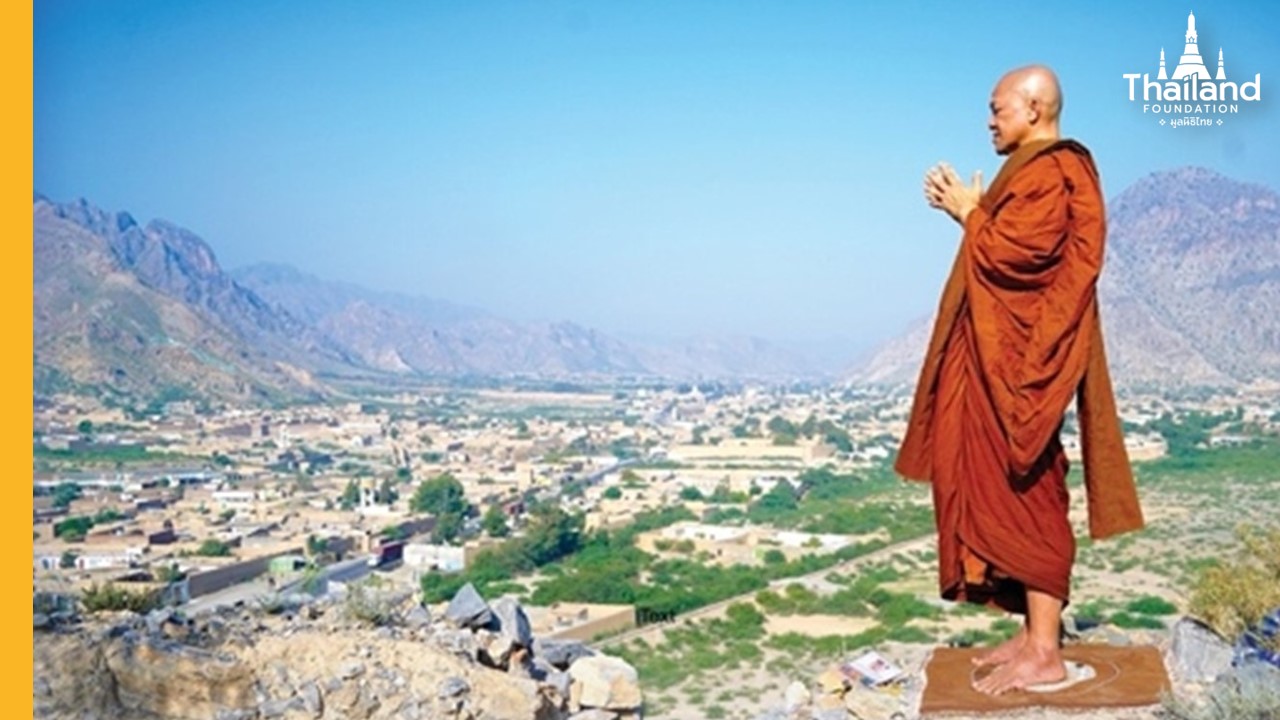
Dhamma Diplomacy for Peace:
Legacy of a Historic Rains Retreat in Taxila, Pakistan[1]
The Flower of Peace blooms in the midst of mind… with wisdom.
~~~~~~~~~~~~~~~~~~~~~
Peace flourishes from friendship, sincerity and mutual sharing of goodwill and understanding – regardless of any differences in nationalities, religions, languages, cultures, and traditions.
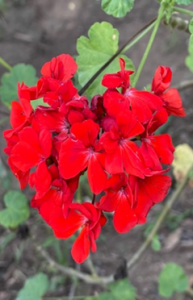
This Geranium is a symbol of true friendship.
The photo was taken from the backyard of the guest house where I stayed during the BE2565 rains retreat in Taxila.
MV Arayawangso
6 September 2565
Accomplishing Dhamma Diplomacy.
It was a great privilege for me to accompany Phra Ajahn[2] Arayawangso on his Dhamma Mission to the Islamic Republic of Pakistan during July – October 2022. This was my second visit to this ancient land, the first one being in October 2019[3] — also as a member of Phra Ajahn Arayawangso’s party.
As this visit was at the invitation of the Pakistan government through the Ministry of Tourism of Punjab for him to observe a three-month rains retreat in Taxila, Phra Ajahn Arayawangso made it clear from the very beginning that monks and lay disciples conduct themselves in a meticulous circumspect manner and with utmost sensitivity at all times.
The delegation of six Thai monks and one novice settled into the guest residence of Taxila Museum where the celebrated British archaeologist Sir John Marshall had lived in the early 1900s. The residence was properly transformed into a monastic compound with the Dhammachaka flag hoisted alongside Thai and Pakistani flags in the front yard. It was from here that Phra Ajahn Arayawangso began his Dhamma mission to perpetuate the legacy of Buddhist civilisation in Gandhara.
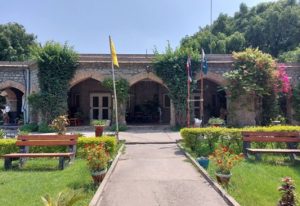
On 13 July, most probably for the first time in over a thousand years, Thai, Bangladeshi and Korean Buddhists celebrated the Asalha Bucha day at the ancient Dhammarajika Stupa, ushering in the B.E. 2565[4] rains retreat on the following day.
The determination ceremony announcing the beginning of the rains retreat on 14 July was performed by the Sangha[5] according to the Dhamma Vinaya in the inner hall of the monastic residence.
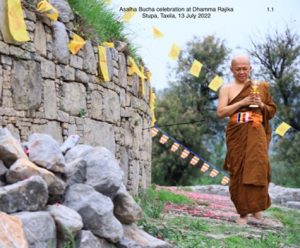
A daily routine was then established that would be the norm until the last day of our stay in Pakistan: morning alms round by the Sangha in the Residence front yard, then a Dhamma talk by Phra Ajahn Arayawangso on various Dhamma topics and monastic practices, with live broadcast for the benefit of his international followers.
The morning session ended with sharing of the meal. Lay disciples then returned to their abodes in the Islamabad compound, while the monks spent the rest of their time in solitude or working on some chores. The day concluded with an evening chant and Dhamma talk at their residences.
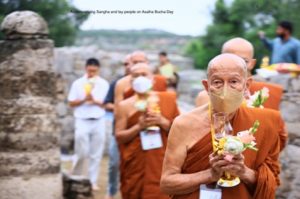
Such a flurry of activities was welcomed by our hosts in Taxila – once the important centre of Gandharan civilisation. They in no small way awakened the Buddhist spirituality of the ruins of Buddhist Heritage which, in Phra Ajahn’s view, had been lost these thousands of years – turning the monuments into mere bricks and stones to most Pakistani people.
Observing Phra Ajahn Arayawangso ‘s conduct of his Dhamma activities during the rains retreat, I was reminded of a term used by Mr Don Pramudwinai, Thai Deputy Prime Minister and Foreign Minister, to define Phra Ajahn’s first visit to Pakistan: Dhamma Diplomacy.
What is Dhamma Diplomacy?
Phra Ajahn Arayawangso provides a clear definition to this term:
“Dhamma Diplomacy is the application and integration of the Dhamma principles which are universal truth that exists in nature to the spirit of all mankind. Realising this truth will benefit our own lives, society and countries without being stuck in the framework of local traditions, cultures, creeds, beliefs or religions.
The conduct of Dhamma Diplomacy should lead to concrete results benefitting equally and justly all concerned. It needs to be applied with loving kindness, compassion, goodwill and equanimity that will create spiritual ties through Dhamma principles of respective religions with common aspiration for Peace. This means Spiritual equality is the aim of Dhamma Diplomacy rather than materialistic gains or following stringent conventional religious beliefs.
Upholding the Dhamma will give us an opportunity to create universal or international religions for the benefit of humanity. And that will let all human beings walk together hand-in-hand towards the ultimate goal of Peace.”
The term Dhamma has often been misunderstood to be related specifically to religion. To this, Phra Ajahn Arayawangso emphatically maintains that:
“Dhamma is not religion. Dhamma exists in all religions. Dhamma binds all religions together.”
Religions are not adversaries if followers truly understand their respective religions which aim at leading humanity onto the common path of peace and happiness.
I have found that this definition and understanding remain at the heart of his Dhamma mission in Pakistan. It is a mission of Peace.
As a consequence, activities undertaken by Phra Ajahn Arayawangso and his monks were much appreciated by the local people – as can be gauged from the reactions from various quarters, private and public, press interviews and reports. Phra Ajahn often maintained that the reason his activities had been well received was because they were pursued with “…intent, understanding and sincerity.”
Phra Ajahn Arayawangso is a Buddhist monk who strictly observes the Monastic Discipline and has full confidence in the virtues of the Triple Gem (Buddha, Dhamma, and Sangha). This confidence is amplified by his close involvement with the Buddhist World Heritage in the Islamic Republic of Pakistan, beginning from his first visit in 2019 and continuing to the present day.
In his article in the Bangkokbiznews dated 10 November 2019, Phra Ajahn Arayawangso wrote that his main objective in visiting Pakistan was:
“…to create religious ties through the Buddhist World Heritage in Pakistan. Buddhist countries can be linked constructively to the Islamic Republic of Pakistan as they share the same objective of developing these World Heritage sites for the common interest of mankind.”
As a retired diplomat, it has been gratifying for me to observe Phra Ajahn Arayawangso practicing his unique way of extending goodwill and empathy, as well as offering advice and comments when sought. From my perspective, his approach to any of his work, the local authorities and people he met has been taken with natural diplomatic finesse and sincere inter-faith respect to our hosts.
He has combined both his devotion to the Triple Gem, which has inspired him to revisit this country, and his sense of history that is apparent in his approach to the Buddhist World Heritage in the context of today’s Pakistan.
The rains retreat in Taxila was three months of unique and amazing activities undertaken by Phra Ajahn Arayawangso on his mission to create spiritual ties with the people of Pakistan in pursuance of the common goal of Peace.
The following are highlights of the activities that contributed to the accomplishments of his Dhamma mission.
Visits to Buddhist World Heritage sites in Taxila, Swat, Peshawar
At the invitation of the Directorates of Archaeology and Museums of Punjab and Khyber Pakhtunkhwa, Phra Ajahn Arayawangso and his party visited a number of important Buddhist World Heritage sites. At every place, he would lead us in paying homage to the Triple Gem, meditating and spreading loving kindness to all beings.
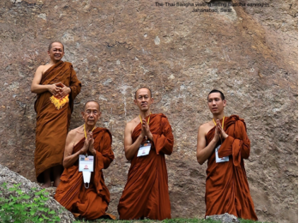
Why, a non-Buddhist might ask. According to Phra Ajahn, it is to awaken the Buddhist spirituality of the once holy sites, which had been lost these thousand years. Pakistani people will then realise that these stupas and monasteries were not just ruins of bricks and stones but living treasures that have been passed down to them.
They should be properly protected and preserved for humanity’s sake. Spreading loving kindness blesses the spirit of people in the past and the present, creating a peaceful environment.
In his view, when there is peace and security, foreign tourists will visit Buddhist World Heritage sites in Pakistan again.
Visit to Swat Valley and Installation of the Third Bell of Peace[6]
Phra Ajahn Arayawangso’s main objective in visiting Swat Valley this time was to keep a promise that he had made to the late Miangul Adnan Aurangzeb, Wahi of Swat, at his first visit to Pakistan. That was to install a third Bell of Peace at the Swat Museum.
It was a touching visit to the Aurangzeb family who bonded spiritually with him. He and the monks were invited to stay at the Residence and performed a blessing ceremony for the family.
Subsequently, he was invited to stay overnight in the Museum where the Patimokkha[7] ceremony by four Buddhist monks took place for the first time in probably over a thousand years in Swat.
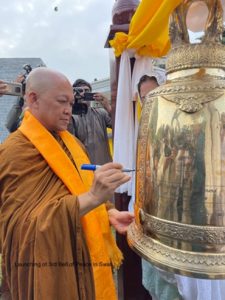
The installation ceremony of the Bell of Peace took place on 28 July 2022, which coincided with the Birthday Anniversary of HM the King of Thailand. So, it was a happily arranged celebration, with participation of the Aurangzeb family, museum representatives, the mass media and the Thai party.
Phra Ajahn Arayawangso deftly played a diplomatic role of Dhamma Peace conveyor by having a Bell of Peace installed on this land, followed by the symbolic ringing of the Bell. The event was widely reported in local newspapers and on TV channels.
Visit to Kanishka Vihara (Shah-ji-ki-Dheri), the tallest Buddhist stupa in the 2nd CE, presently located in a community cemetery
To get to the site of the ruins, Phra Ajahn Arayawangso, escorted by the Director of Archaeology and Museums of KPK, and his party had to take a long walk passing through a Muslim community cemetery.
Our intrusion into the compound seemed not to have caused any problem for the local people who gradually formed a big group to quietly watch a Buddhist monk build a small sand stupa underneath a big Bodhi tree on the ground where the old stupa used to stand. Form his part, Phra Ajahn also quietly went about working on the sand stupa, in a subdued meditative manner.
There was no chanting, just praying and paying homage to the Triple Gem at the completion. Later, Phra Ajahn said to us that as we were in a Muslim cemetery, we should display proper respect to their traditions. It was generous of the local people to have let us go through.
The people, particularly, school children, were friendly, courteous, and curious to meet Phra Ajahn and take photographs with him. Such expressions of friendly welcomes greeted Phra Ajahn Arayawangso everywhere he went.
Visit to Khyber Pass
Phra Ajahn Arayawangso called the Khyber Pass “…The Gateway to Civilisation.” He made two impressive visits to this northern frontier region which is still restricted to the general foreign tourists.
The Director of Archaeology and Museums of KPK arranged for Phra Ajahn Arayawangso to climb up the Sphola Stupa, the only Buddhist monument from Ashoka period remaining in the Khyber Pass which was being used as a frontier guard post, and to the Frontier Agency from where we could see the border with Afghanistan.
According to the Director, there had not been a Buddhist monk visiting the stupa for over a thousand years!
It was a visit welcomed by the local authorities, including the Archimedes, a frontier tribe which presented Phra Ajahn with a Chieftain hat as an expression of friendship and respect.
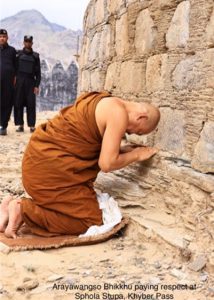
The visits have greatly inspired Phra Ajahn Arayawangso in his Dhamma mission for Peace. For this, he mentioned a concept of constructing a Vihara (a building for worship) where people of all faiths can come to spend time in tranquillity. The venue for this Vihara has still to be decided. Should this concept be realised, it would constitute a concrete result of Dhamma Diplomacy.
Lecture at the National School of Public Policy
At the invitation of the National Management College of the National School of Public Policy, Lahore, Phra Ajahn Arayawangso gave a special lecture to the 116th Class of 53 high ranking officers on the subject ‘Dhamma: Buddhist Teachings and Pakistan’s Role as Cradle of Civilisation’. This, I believe, was the first of such invitation to a Buddhist monk.
The lecture provided an opportunity for Phra Ajahn Arayawangso to share his thoughts on what is Dhamma and how Pakistan could develop its Buddhist World Heritage to promote cultural tourism. Although the title of the talk set by the school refers to Buddhist Teachings, Phra Ajahn Arayawangso avoided wherever possible the use of the terms “religion” “Buddhism” or “Buddhist civilisation” in his lecture.
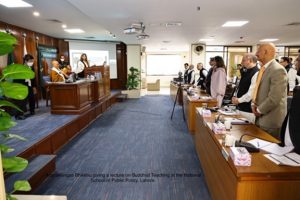
Instead, with his usual sense of history, he pointed to the Indus Valley Civilisation as the root of all subsequent civilisations of Pakistan. His objective was to raise the awareness and interest of the students to the spiritual values of the ruins from past Civilisations, including the Buddhist World Heritage, so that appropriate strategies would be formulated at the high level to implement the cultural and religious tourism aspired to by Pakistani government. His lecture was well received by the students and faculty of the college.
Donation to Disaster Relief
As soon as he learned about the flooding in Pakistan – particularly the dire situation in Swat – Phra Ajahn Arayawangso decided to do something to help relieve the plight of people there. Within 24 hours, his disciples in Thailand raised one million Thai Baht (or 6 million Pakistani Rupees) for disaster relief to collaborate, among others, with the Miangul Adnan Aurangzeb Fund established by the Aurangzeb family and friends. The donation was passed on to the Pakistani Foreign Ministry through diplomatic channels.
At the end of his stay, Phra Ajahn Arayawangso also made a donation directly to the Mangul Adnan Aurangzeb Foundation to support school children in Swat. Such humanitarian relief was a sincere act of friendship and empathy towards Pakistani victims affected by the disastrous flooding.
Writing a book on Gandhara
During his Dhamma mission in Pakistan, Phra Ajahn Arayawangso was preoccupied with the research and analysis that went into his book titled Buddhist Civilization in Gandhara by Arayawangso Bhikkhu – a tribute to the Buddhist heritage in Islamic Republic of Pakistan.
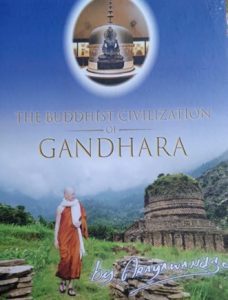
According to Phra Ajahn, he wanted to share with the people of Pakistan correct knowledge of the spiritual value and significance of the places he visited. They might now be ruins of bricks and stones but thousands of years ago, they were full of spiritual vibrancy. It was his hope that given correct knowledge, the people would appreciate their ancient heritage and want to give it due attention and protection.
The copyright of the book was gifted to the Directorate of Archaeology and Museums of Khyber Pakhtunkhwa.
Organisation of Kathina Ceremony (offering of the Robe) to mark the end of rains retreat in Taxila on 12 October 2022
In Thailand, according to the Dhamma Vinaiya, a monastery can receive a Robe offering from lay donors within one month after the end of the rains retreat. It is a normal tradition. But to organise one in Pakistan was indeed historic.
This event had been planned by Phra Ajahn Arayawangso even prior to his coming to Pakistan! Apart from over 150 Buddhist followers from Thailand, a big crowd of Pakistani friends and diplomatic representatives from Thailand, Sri Lanka, Myanmar, Indonesia, Malaysia, Vietnam, EU and USA also participated in this ceremony at the monastic compound in Taxila.
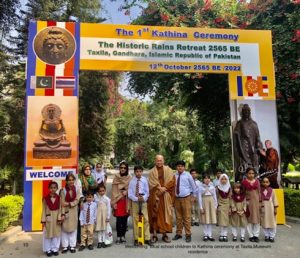
As part of their trip to Gandhara, the Thais also enjoyed visiting Buddhist World Heritage sites and museums in Taxila, Peshawar and Lahore. This was the first group of religious tourists of this size coming to see for themselves what Pakistan has to offer to Buddhists all over the world.
The success of this pilgrimage is attributable seamlessly to Phra Ajahn Arayawangso’s initiative to preserve the cultural legacies of Buddhist Civilisation in Gandhara, an important element of his Dhamma mission during the rains retreat.
A Gift of Buddha’s Relics and replica of Buddha’s Alms Bowl to Peshawar Museum
As the final act of friendship, Phra Ajahn Arayawangso presented the Museum with Buddha’s relics bestowed to him by the late Supreme Patriarch of Thailand, along with a replica of the Buddha’s Alms Bowl.
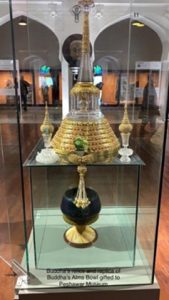
It is interesting to note that the Peshawar Museum has on display an empty 2nd century stone casket discovered by British archaeologists at Kanishka Vihara, which contained fragments of what are believed to be Buddha’s relics. They are presently kept at a monastery in Myanmar.
While the Buddha’s Bowl, recorded by the Chinese monk, Fa Hien, as being worshipped at the Gor Gathri monastery in Peshawar, has been lost for centuries. And now, both Buddha’s relics and Bowl have been symbolically returned to Gandhara.
Conclusion
The Dhamma Diplomacy as practiced by Phra Ajahn Arayawangso in Pakistan has created a strong momentum for closer diplomatic relations between Pakistan and Thailand in mutually beneficial ways – particularly in the field of religious/cultural tourism.
It has also opened up vast possibilities for peaceful development in the region with Pakistan acting as a bridge for people from all over the world to visit and enjoy the fruits of its multicultural heritage. Thailand can play a leading role in promoting Dhamma Diplomacy as an instrument for global peace so that all peoples can work together in harmony.
“Whether we are considering religious matters or working on maintaining goodwill between people, ‘Dhamma Diplomacy’ is the most appropriate path to genuine world peace. It is a method which diplomats should sincerely bear in mind as they work for the benefit of mankind.”
Arayawangso Bhikkhu
Pak Thong Dhamma, Thai Post newspaper, 4/11/2022
Notes:
[1] The earlier version of this article was published in the book ‘Buddhist Civilization in Gandhara by Arayawangso Bhikkhu’.
[2] Phra Ajahn is a title used when speaking or referring to a monk as venerable teacher.
[3] MV Arayawangso’s first visit, at the invitation of the Embassy of Pakistan in Bangkok, took place from 28 October to 2 November in 2019.
[4] BE-Buddhist Era, 543 years before the Christian Era
[5] Sangha in Buddhism: the collective name for the monastic Buddhist community, comprising monks, nuns, laymen and women.
[6] The 1st Bell of Peace was installed at Peshawar Museum on 30 October 2019; the 2nd Bell of Peace was installed at Taxila Museum on 31October 2019.
[7] In Theravada Buddhism, the Patimokkha is the basic code of monastic discipline consisting of 227 rules for fully ordained monks. The entire Patimokkha is recited during the Ubosatha or fortnights assembly of at least 4 monks.
____________________________________________________________________________________________________________
Author: Suchitra Hiranprueck
18 May 2023


